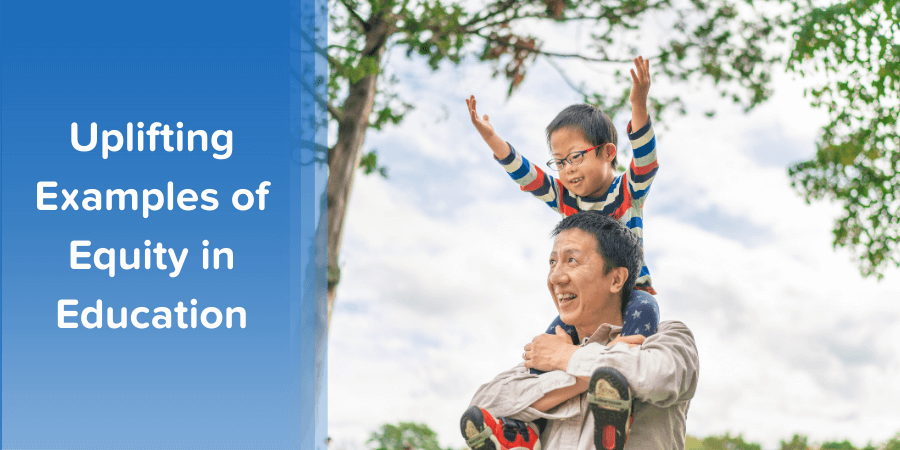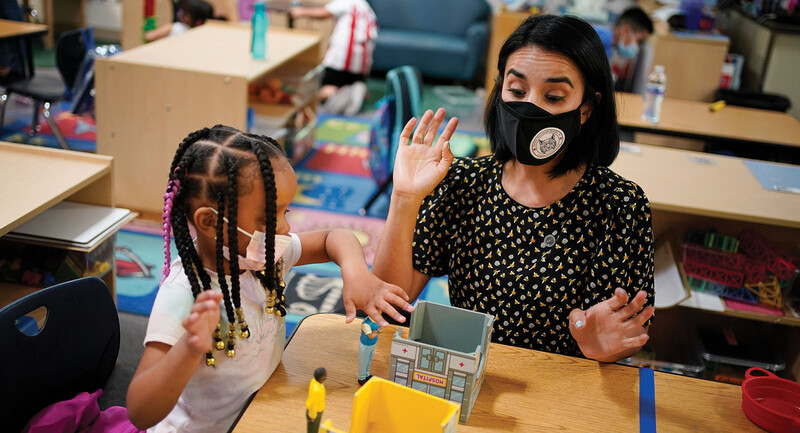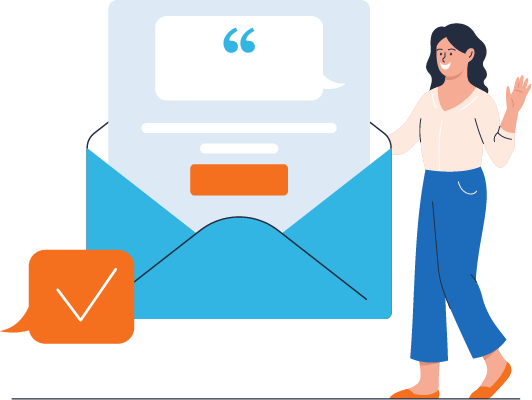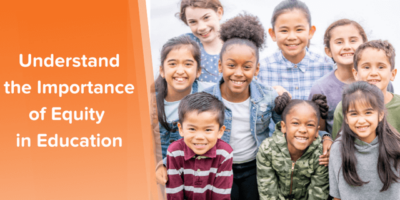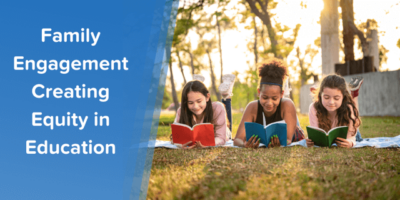by ParentPowered contributing author Curran Mahowald, M.A. Cognitive Science in Education
Like so many other educators, I became a teacher so I could help all students learn and thrive. Equity is the idea that any student, no matter their background, can reach their potential through high-quality public education— it is essential to achieve this goal. And I was motivated to promote equity in education systems by creating equity in the classroom.
I was so motivated, in fact, that I moved from a sunny suburb in my home state of California to the unfamiliar state of Indiana, where an urban public charter high school needed a French and English teacher.
I may have been naive about midwestern living (hello, seasons!), but I wasn’t naive about the barriers to education equity faced by students of color, students from low-income families, and others in high-poverty schools. Research reveals that a significant gap in academic achievement exists between student groups across learning environments. For example, according to data analysis from the Educational Opportunity Project at Stanford University, the difference in standardized test scores between black and white students amounts to about two years’ worth of learning.
As I strove to create an equitable learning environment that would help all students succeed, I myself learned a lot about educational equity.
To truly promote equity in schools means using research-based best practices and support systems that benefit diverse learners. Equity in the classroom also requires providing extra resources to help students with differing levels of language skills and disabilities.
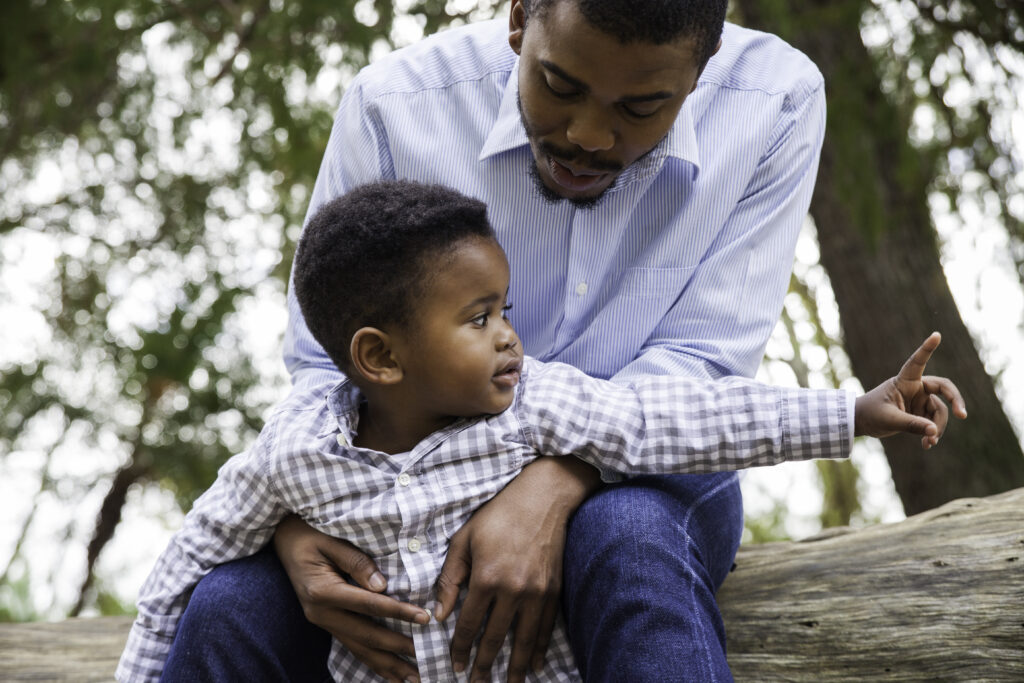
Efforts to create equitable educational opportunities are necessarily tailored to their context and thus take many forms to meet the needs of different students. But the unifying principle of promoting equity for students is simple: “Every student has access to the educational resources and rigor they need at the right moment in their education across race, gender, ethnicity, language, disability, sexual orientation, family background and/ or family income” (Council of Chief State School Officers / The Aspen Institute).

5 real-life ways that educators promote equity
Building an equitable classroom and education system can seem like a lofty ideal that is difficult to put into practice. Fortunately, we can look to the example of educators and education leaders to understand what it looks like to reduce equity gaps in public schools.
In a two-part series, we highlight examples of equity in education from the field, featuring leaders working to drive equitable outcomes in public schools starting with their local school system. Read on to hear from these educators directly and discover how they created an equitable classroom, stronger relationships with their students, integrating trauma-informed practices, and much more.
1. Early education for the whole child
Berol Dewdney, Pre-K teacher in Baltimore, Maryland (Interview with Teach for America)
Early childhood education significant impacts a child’s later academic success. Research consistently shows that children who attend high-quality early childhood education programs have better academic outcomes later in life, from stronger kindergarten readiness to higher rates of high school graduation and even college attendance.
Berol Dewdney’s approach to creating this high-quality early learning environment is based on two well-established findings from education research. First, children in preschool need to develop key pre-academic and socio-emotional skills especially oral language and executive function (Road to Readiness report from the Overdeck Family Foundation). Second, children learn best from play. That’s why Dewdney, like many early childhood educators who embrace rigorous play-based learning, focuses on allowing children to build cognitive skills through playful exploration.

By giving students a supportive environment to explore and play, Dewdney demonstrates how kids can safely build early learning skills that promote future student outcomes—an inspiring example of how to foster equity in the service of the youngest learners.
Explore these resources to learn more about advancing equity in early childhood education:
- “Advancing Equity in Early Childhood Education” — Read this position statement from the National Association for the Education of Young Children.
- “Untangling the Evidence on Preschool Effectiveness: Insights for Policymakers” — Take a look at a research brief from the Learning Policy Institute.
- “The Power of Play: A Pediatric Role in Enhancing Development in Young Children” — Explore a clinical report from the American Academy of Pediatrics.
2. Prioritizing relationships to close the achievement gap
Rodney Robinson, district administrator and former middle and high school teacher in Richmond, VA (Interview for The Teacher Education Podcast)
Educators hoping to close the achievement gap may be focused on strictly academic elements such as classroom strategies to instruction and assessment design. But research shows that the relational aspects of equity in the classroom are just as worthy of attention in public education.
Teachers’ relationships with students are paramount. For students in traditionally underserved groups especially, positive relationships with teachers can help provide a supportive school environment in which students overcome barriers and thrive. These connections also invite student voice into learning when teachers truly listen and respond to students’ unique perspective, needs, and goals.

Teachers can also look beyond the classroom level to understand the neighborhood and community where students live, including its history. Last, they can take time to learn about their students’ culture and its impact on their experience with school.
District administrator Rodney Robinson says he makes an effort to go to after-school events like football games to be present in the school community. Listening goes a long way, he adds, and unconditional love and support to encourage students are not to be underestimated: “Wherever the heartbeat of the community is, you should be there.” As important as teaching methods are, Robinson sees the relationships he builds with students as core to his concept of equity in education systems.
Take a look at these resources to learn more about building student-teacher relationships and how they create equitable outcomes for students:
- “Why Teacher-Student Relationships Matter” — Read this article from Education Week.
- “Improving Students’ Relationships with Teachers to Provide Essential Supports for Learning” — Explore this article from the American Psychological Association.
3. Building resilience through trauma-informed programming for caregivers
Domenic Russo, principal in Las Vegas, NV (Case Study from ParentPowered)
More than half of children in the U.S. experience at least one adverse childhood experience (ACE). Left unaddressed, these experiences can hinder children’s ability to succeed in learning environments. Fortunately, research shows that the effects of trauma can be buffered. Nurturing, supportive relationships with caring adults from an early age can mitigate or even reverse the detrimental effects of trauma.
Trauma-informed practice is key to educational equity because trauma can have a significant impact on how successfully students learn and succeed in school. Mitigating the impact of trauma on children and families helps ensure that all students have the opportunity to thrive in their education, regardless of their experiences or background.

Based on his assessment of the needs of his elementary school community, Principal Domenic Russo decided to prioritize social-emotional learning for both students and families. One program within the school’s multi-tiered systems of support (MTSS) is ParentPowered Trauma Informed. Through this program, parents receive weekly text messages with tips to build strength to navigate difficult situations and provide responsive caregiving to their children.
Parents and caregivers also receive a separate stream of messages with direct links to local resources. The resources range from basic needs and job assistance to new parent education support to addiction treatment, recovery, and prevention programs. Education research strongly suggests that meeting basic needs is a critical component of advancing educational equity, especially for children from families impacted by trauma. Schools that provide comprehensive support and access to community resources to ensure students have adequate food, shelter, and healthcare can improve academic achievement, reduce absenteeism, and reduce disciplinary incidents.
As this school administrator put it, this concept of ensure families could access or at least learn about the same resources was a no-brainer: “The idea that it’s a way to connect with families in such an easy format, through texting, with ideas that are easily usable—why wouldn’t you?”
To learn more about mitigating the effects of trauma on education, explore these resources below:
- The Protective Factors — Discover the framework from the Center for the Study of Social Policy’s Strengthening Families.
- Trauma-Attuned Practices Showcase — See examples of bright spots from the field in this webinar from Head Start ECLKC.
- Family Engagement within Trauma-Informed Schools — Leverage this toolkit from Ohio Statewide Family Engagement Center.
- Considerations for Trauma-Informed Child Care and Early Education Systems — Review a recent report from the U.S. Department of Health and Human Services, Administration for Children & Families.

4. Partnering with families to support English Language Learners
Juliana Urtubey, bilingual special education teacher in Nevada (Interview with ACSD)
Families are allies for educators to create equity in the classroom, especially when it comes to academic skills and determining the best ways to support students who are English Learners. They are also a rich resource when it comes to serving children with learning differences or different physical ability.
The funds of knowledge of immigrant families (also known as “newcomer” families) are too often undervalued or overlooked by most schools. Culturally responsive family engagement that fosters genuine two-way relationships can help with this.
Juliana Urtubey sees each student as a complex individual in the context of their communities, cultural backgrounds, and history. She enhances school-family partnerships beyond communication into shared projects, like a community garden that allows parents to contribute culturally and materially to school assets and students’ learning. The pandemic highlighted the importance of family-school relationships in education, and not just when remote learning was ubiquitous: “Our students’ progress and wellness depended on us being able to partner with families.”
As a bilingual herself, Urtubey knows that providing accommodations like translation for families who speak a language other than English is necessary—but not sufficient to enact culturally responsive family engagement and cultivate thriving learning environments. Families can truly be themselves when they receive the message that “[w]ho you are matters to our school, we have things to learn from you, we want to really know who you are.”
The idea of seeing strengths also extends to students with disabilities. Urtubey recommends having an open conversation with parents about what works best to support that student’s education, rather than immediately labeling them with a disability. This is key because the word ‘disability’ can carry different connotations in other cultures, and not all students or families may feel receptive or supportive to additional support if framed this way.

Finally, it’s important to remember that school-family relationships are not about the adults but rather about centering students individually. These relationships should be intentionally oriented to setting each learner up for success. Urtubey speaks of a relationship she built with a parent of a student with autism who was transitioning to general education: “It was through this relationship that I had with her mom that Leila eventually started feeling comfortable in school. Once she did feel comfortable, her academics flourished.”
Here are more resources to learn about family engagement for parents of students who speak a language other than English at home and students with disabilities:
- English Language Learners in Special Education: How to Partner With Your Students’ Families — Article from Colorín Colorado
- Exploring Equity: Dis/ability — Read this article from the Harvard Graduate School of Education’s Usable Knowledge series.
5. Using data for continuous improvement
Jessica Lazzara, VP of Education and Research at Jumpstart (Case Study from ParentPowered)
Surveying families not only helps involve them as true partners, but it also enables education leaders to get a clearer picture of what works. Jessica Lazzara and her team at Jumpstart support caring adults in local communities to ensure all children get the quality early education they need to enter kindergarten ready to learn. She and her team were interested in better understanding their program’s impact on families and students’ early education.
Low-lift high-impact family engagement tool ParentPowered allows Jumpstart to communicate with families more universally and consistently than pick-up and drop-off alone would allow. It also provides a parenting curriculum in bite-sized, easy-to-use tips for promoting key areas of learning and development during everyday moments. Jumpstart used ParentPowered to conduct a survey to determine whether children were benefiting from families using these tips.
The Jumpstart team can also see which links families click on to learn more, which helps them tailor the resources they provide to families’ areas of interest and need. These are just a few examples of how using data for continuous improvement in education systems can help ensure that all students have access to what they need to learn and thrive.


Creating New and Powerful Examples of Equity in Education
Equity in education aims to give every child the same opportunities and ability to reach their full and unique potential. Educational equity is both universal and personalized to promote successful student learning for the entire classroom using tailored support. What this support looks like is as varied as the diverse children that educators serve.
The perspectives shared above are just a sampling of many ways that equity work in schools can look. From community schools to diversity and representation in staff and materials, there are many more promising practices being used to level the playing field. And of course, there are many, many more educators and families working day in and day out to make good on the promise to help every student learn, grow, and thrive to their fullest potential.
Continue exploring more equity examples in education in the second part of this series.

About the author
Curran Mahowald is a former high school language teacher turned education research advocate. In addition to having worked at ParentPowered, she has also designed parent-facing informational materials at Oakland Unified School District and currently works on improving national research-to-practice infrastructure at the Annenberg Institute for School Reform at Brown University. Curran holds an M.A. in Cognitive Science in Education from Teachers College, Columbia University and B.A.s in Linguistics and French from the University of Southern California.

